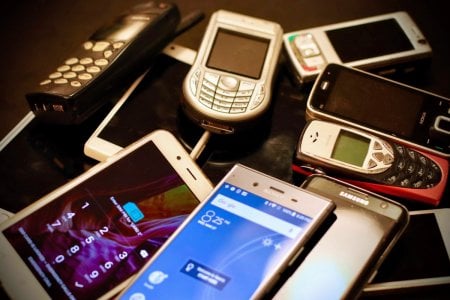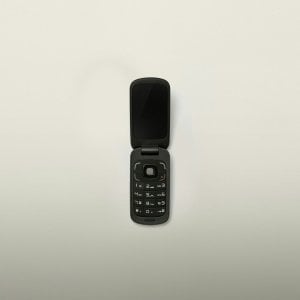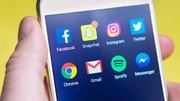Discover why savvy Australians are ditching their smartphones for 'dumbphones'
In an era where smartphones are practically an extension of our hands, a surprising trend is emerging in the country.
A small but growing number of Australians are trading in their high-tech smartphones for simpler, less distracting 'dumbphones' or feature phones.
Smartphones, with their myriad of apps and features, have become indispensable tools for personal and professional tasks.
However, they also come with a host of potential issues, including social media and gaming addiction, expensive data bills, reduced attention spans, and even feelings of isolation.

A 2019 study found that problematic mobile phone use in Australia had increased since 2005, with more people feeling lost without their devices or experiencing issues such as sleep loss.
The study found that women and those aged between 18 and 24 exhibited the most problematic mobile phone use, but older age groups also saw an increase in such issues.
This has led some Australians to revert to simpler times when old-school 'flip' and 'brick' phones dominated the market.
One of those people is Sydney University student Arianna Lahiri, who switched from an iPhone to a second-hand Japanese flip phone in late 2023—a switch that cost her $250.
The 19-year-old found inspiration in the resurgence of 90s and early 2000s fashion, the growing trend of flip phones, and a personal wish to reduce screen time on her primary device.
'It was the doomscrolling on TikTok that really got me,' she said.
'I would get stuck there and wouldn't be able to feel time move around me. I realised this one night when I was going to go to bed—I said to myself, “Okay, 10 more minutes, then bedtime.” It turned into three hours, and I didn't notice at all!' she added.
Arianna found that deleting apps from her smartphone was a temporary solution at best.
Switching to a simpler phone reduced her temptation to use her device and encouraged her to communicate with friends over the phone more often rather than relying on messaging apps.
Arianna’s switch was met with positive responses from friends, family, and even strangers.
'I was out at a goth club, and a bunch of people were like, “A flip phone?!” They took photos of me with it—it was very fun,' she shared.
'It has helped me with my mental health and has made my day-to-day life much more interesting. I can finally force myself to be productive or read a book—just anything outside of technology.'
Another person to make the switch is David Sorauer, a Sydney-based marketing business owner, who uses a smartphone for work but turns to his feature phone when he's off the clock.
He found that the constant notifications and accessibility of his smartphone made it difficult to focus.
'I felt like I was constantly on call and answerable to all different people and expected to respond to messages instantly,' he expressed.
'I feel freer using a dumbphone. I find there's a lot more clarity,’ David admitted.
David tried various strategies to reduce his smartphone usage, such as switching his screen to black and white and limiting the number of apps on his device.
However, he found that he needed a more significant barrier.
'I needed to get a phone that's not sexy, and that's why I purposefully went for a flip phone,' he stated.
'I don't like flip phones at all, but just to have that additional friction: you've got to open it up to use it…That friction is really important for me…The device, as well as the software, is part of the problem—for me anyway.'
However, David acknowledged that the switch was challenging and that it impacted some of his relationships.
‘Friends look at you a bit strangely. They don't really understand and they think you're a bit weird…but there's a lot more clarity as a result,’ he shared.
‘I feel a lot freer. I feel like my brain functions better. Without the distractions and notifications, it's much easier to focus, and I'm more productive,’ he added.
Google Search data revealed an 89 per cent increase in searches for dumbphones worldwide from 2018 to 2021, according to software firm Semrush.
Videos about dumbphones and retro devices have also garnered hundreds of thousands of views on TikTok, where more than a third of the audience is aged between 18 and 24.
Despite the increasing interest, feature phones still make up a small portion of Australia's mobile phone market.
According to technology analyst firm Telsyte, just under 1 million Australians were still using dumbphones or feature phones in 2023.

Alvin Lee, a Senior Analyst at the company, stated that the number is declining 'due to the increasing availability of affordable smartphones in the sub-$200 range, and because most mobile plans now include data'.
While there is a growing interest in dumbphones among the younger generation in the United States due to 'a digital detox trend in 2022 and 2023', they haven't made a true comeback in Australia.
'Two-thirds of the [Australian] 16-34-year-olds we surveyed said that smartphones remain their primary digital device,' Lee said.
‘Telsyte's research found [feature] phones are most popular among seniors in Australia, with over half of users aged above 65,’ he added.
Despite declining sales, dedicated feature phone companies have entered the market.
Firms like Punkt and Light make phones with intentionally limited functionality—Light even claimed its devices were 'designed to be used as little as possible'.
Industry researcher Kiranjeet Kaur from the International Data Corporation (IDC) revealed that a number of companies have introduced 'something like a smart feature phone', which offers 'a little more than texting and voice calling capabilities that traditional feature phones do'.
These have gained some traction in emerging markets where the price point makes them more attractive than smartphones.
For some Australians, the lower cost of dumbphones is a significant factor, especially amid the current cost-of-living crisis.
'I would 100 per cent recommend [a dumbphone] to people who want to get away from social media and be more awake to the world around them,' Arianna said.
'It is also cheaper than any modern phone, so you could always give it a try without breaking the bank,’ she added.

What are your thoughts on this, members? Which do you prefer: smartphones or dumbphones? Let us know in the comments below!
A small but growing number of Australians are trading in their high-tech smartphones for simpler, less distracting 'dumbphones' or feature phones.
Smartphones, with their myriad of apps and features, have become indispensable tools for personal and professional tasks.
However, they also come with a host of potential issues, including social media and gaming addiction, expensive data bills, reduced attention spans, and even feelings of isolation.

An increasing number of Australians are switching back to basic feature phones. Image source: Eirik Solheim/Unsplash
A 2019 study found that problematic mobile phone use in Australia had increased since 2005, with more people feeling lost without their devices or experiencing issues such as sleep loss.
The study found that women and those aged between 18 and 24 exhibited the most problematic mobile phone use, but older age groups also saw an increase in such issues.
This has led some Australians to revert to simpler times when old-school 'flip' and 'brick' phones dominated the market.
One of those people is Sydney University student Arianna Lahiri, who switched from an iPhone to a second-hand Japanese flip phone in late 2023—a switch that cost her $250.
The 19-year-old found inspiration in the resurgence of 90s and early 2000s fashion, the growing trend of flip phones, and a personal wish to reduce screen time on her primary device.
'It was the doomscrolling on TikTok that really got me,' she said.
'I would get stuck there and wouldn't be able to feel time move around me. I realised this one night when I was going to go to bed—I said to myself, “Okay, 10 more minutes, then bedtime.” It turned into three hours, and I didn't notice at all!' she added.
Arianna found that deleting apps from her smartphone was a temporary solution at best.
Switching to a simpler phone reduced her temptation to use her device and encouraged her to communicate with friends over the phone more often rather than relying on messaging apps.
Arianna’s switch was met with positive responses from friends, family, and even strangers.
'I was out at a goth club, and a bunch of people were like, “A flip phone?!” They took photos of me with it—it was very fun,' she shared.
'It has helped me with my mental health and has made my day-to-day life much more interesting. I can finally force myself to be productive or read a book—just anything outside of technology.'
Another person to make the switch is David Sorauer, a Sydney-based marketing business owner, who uses a smartphone for work but turns to his feature phone when he's off the clock.
He found that the constant notifications and accessibility of his smartphone made it difficult to focus.
'I felt like I was constantly on call and answerable to all different people and expected to respond to messages instantly,' he expressed.
'I feel freer using a dumbphone. I find there's a lot more clarity,’ David admitted.
David tried various strategies to reduce his smartphone usage, such as switching his screen to black and white and limiting the number of apps on his device.
However, he found that he needed a more significant barrier.
'I needed to get a phone that's not sexy, and that's why I purposefully went for a flip phone,' he stated.
'I don't like flip phones at all, but just to have that additional friction: you've got to open it up to use it…That friction is really important for me…The device, as well as the software, is part of the problem—for me anyway.'
However, David acknowledged that the switch was challenging and that it impacted some of his relationships.
‘Friends look at you a bit strangely. They don't really understand and they think you're a bit weird…but there's a lot more clarity as a result,’ he shared.
‘I feel a lot freer. I feel like my brain functions better. Without the distractions and notifications, it's much easier to focus, and I'm more productive,’ he added.
Google Search data revealed an 89 per cent increase in searches for dumbphones worldwide from 2018 to 2021, according to software firm Semrush.
Videos about dumbphones and retro devices have also garnered hundreds of thousands of views on TikTok, where more than a third of the audience is aged between 18 and 24.
Despite the increasing interest, feature phones still make up a small portion of Australia's mobile phone market.
According to technology analyst firm Telsyte, just under 1 million Australians were still using dumbphones or feature phones in 2023.

Telsyte said just under 1 million Australians were using feature phones in 2023. Image source: Alexander Andrews/Unsplash
Alvin Lee, a Senior Analyst at the company, stated that the number is declining 'due to the increasing availability of affordable smartphones in the sub-$200 range, and because most mobile plans now include data'.
While there is a growing interest in dumbphones among the younger generation in the United States due to 'a digital detox trend in 2022 and 2023', they haven't made a true comeback in Australia.
'Two-thirds of the [Australian] 16-34-year-olds we surveyed said that smartphones remain their primary digital device,' Lee said.
‘Telsyte's research found [feature] phones are most popular among seniors in Australia, with over half of users aged above 65,’ he added.
Despite declining sales, dedicated feature phone companies have entered the market.
Firms like Punkt and Light make phones with intentionally limited functionality—Light even claimed its devices were 'designed to be used as little as possible'.
Industry researcher Kiranjeet Kaur from the International Data Corporation (IDC) revealed that a number of companies have introduced 'something like a smart feature phone', which offers 'a little more than texting and voice calling capabilities that traditional feature phones do'.
These have gained some traction in emerging markets where the price point makes them more attractive than smartphones.
For some Australians, the lower cost of dumbphones is a significant factor, especially amid the current cost-of-living crisis.
'I would 100 per cent recommend [a dumbphone] to people who want to get away from social media and be more awake to the world around them,' Arianna said.
'It is also cheaper than any modern phone, so you could always give it a try without breaking the bank,’ she added.
Key Takeaways
- Some Australians are switching from smartphones to 'dumbphones' to reduce screen time and focus, inspired by nostalgia and fashion trends.
- Dumbphones, or feature phones, are gaining attention as they offer a simple alternative to smartphones, which are often linked to social media addiction and other issues.
- A 2019 study highlighted increased problematic mobile phone use in Australia, particularly among women and the 18-24 age bracket.
- While sales of dumbphones are declining globally, there is a niche market in Australia and worldwide, with companies creating phones with limited functionality to encourage digital detox.
What are your thoughts on this, members? Which do you prefer: smartphones or dumbphones? Let us know in the comments below!








